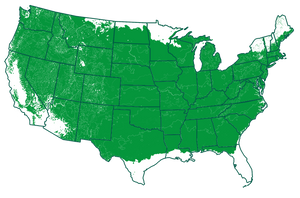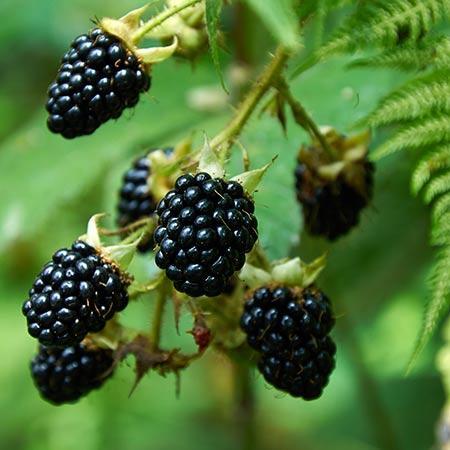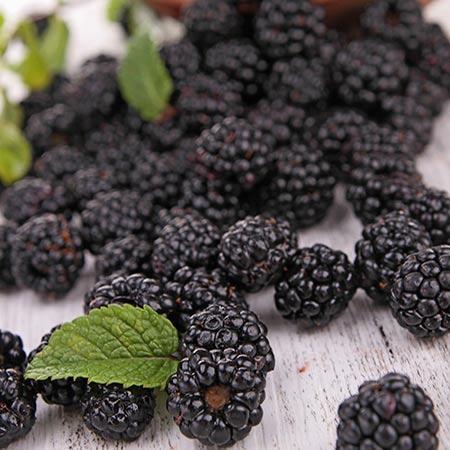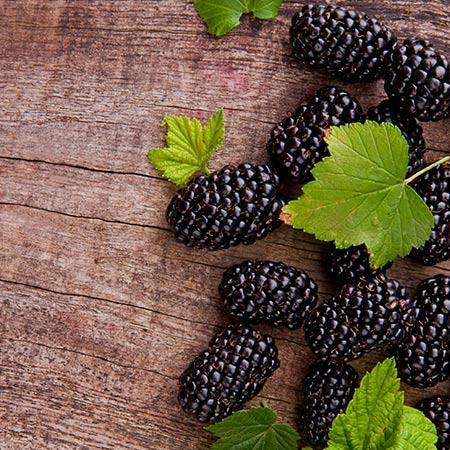* Images shown are of mature plants

Have questions? Talk with our Plant Experts (800) 973-8959
Save 25% on $200+ with code FALL25.
Questions? Call our plant experts: (800) 973-8959
The fastest-fruiting Blackberry shrub
Most Blackberry varieties only produce fruit on canes that are two years old, but the 'Prime Ark Freedom' Blackberry produces fruit on new canes. With this shrub you'll get delicious blackberries up to a year sooner than other blackberry varieties.
This vigorous shrub produces large, juicy berries twice a year. The new canes have berries ready to be harvested early in the season, and the old canes produce a second crop later in the season. You'll get twice the amount of berries!
'Prime Ark Freedom' Blackberries are firm, and full of sweet juices. They make for an excellent snack to eat fresh, pick a few and place them in your yogurt or ice cream for an invigorating treat. These berries are also excellent for baking, and make some of the sweetest pies and jams around.
Due to its compact size, only growing about 4 to 5 feet tall and 3 to 4 feet wide this blackberry shrub perfectly fits in any garden. Use them to line fences or patios, giving your yard a beautiful, lush green look.
If you're looking for savory blackberries that are produced up to a year sooner than the competition then the 'Prime Ark Freedom' Blackberry is for you. Order yours today, before they're gone!
Pollination Info
Prime Ark Freedom Blackberry Pollination
Prime Ark Freedom Blackberrys are self-fertile. You will get fruit with only one plant. However, adding an additional Prime Ark Freedom Blackberry will drastically increase the size of your crop.
Planting & Care
The Prime Ark Freedom blackberry (Rubus fruticosus ‘Prime Ark’) is a blackberry that will fruit within the first year and can produce 2 annual crops. These compact plants can fit into any small garden as they only reach 4-5 feet tall and 3-4 feet wide at maturity. They provide delicious fruit that are perfect for baking, freezing or eating straight off of the cane. This is a cold tolerant blackberry taking temperatures all the way down to -20 degrees and only require 150-200 chill hours, so you can get delicious berries even in southern climates. Growing in USDA zones 4-8, they work well in all but the most extreme hot/cold zones. These blackberries are self fertile, so you only need one to get berries, but will significantly increase your crop by adding a second plant nearby.
Selecting a location: When scouting out a spot for your blackberry bushes, avoid low sitting areas of your yard that collect a lot of standing water or that may be prone to flooding. Also, keep in mind the amount of sunlight that area gets a day. Blackberries prefer full sun but can tolerate partial shade. For the best berry production make sure that your bushes get at least six hours of sunlight each day. For a hedge, plant your blackberries about three feet apart.
Planting Directions:
1) Once you have the location for your bushes selected dig a hole three times as wide as the root ball and just as deep.
2) Take a pitchfork or shovel and run it along the sides of the hole to loosen the soil and remove any dirt clumps, rocks, or grass from the hole.
3) When it’s clear of debris, place your blackberry bush in the hole and make sure that it’s level with the ground and backfill the hole. Use a mixture of your native soil (60%) and sandy compost (40%) to fill the hole. Tamp down the soil as you fill to remove any air pockets that may have formed.
4) Once you’ve finished this process, give your bush a long drink of water and mulch around the base to conserve soil moisture.
Watering: Keep the soil moist, but not over-saturated. Blackberries need about an inch of water of week and more during times of drought. Check on your soil once a week, if it’s starting to dry out then it’s time to give your bush more water. Due to the shallow rooted nature of these plants, they shouldn’t dry out down to six inches below the surface of the soil. However, be careful not to overwater your plants, it’s important not to over saturate the soil. The amount of water needed will depend on your climate and the time of year.
Fertilizer: Blackberry bushes don’t need regular fertilizing unless you know that your lawn is lacking in nutrients. Also, fertilizing your bushes can increase growth and fruit production. You’ll know when your blackberry bush needs fertilizing because it’s leaves will show some signs of discoloration. It’s best to fertilize early in the spring before new growth starts to emerge, then again after your berry harvest. Use a well-balanced, general all-purpose fertilizer like formula 10-10-10.
Pruning: Pruning will help increase your blackberry crop and keep your bushes healthy. After a year of growth in the early spring, take a sterile pair of sharp hand pruners and remove the tips of each woody blackberry cane. If they’re shorter than 24 inches long, only remove the tip back to about an inch. This will cause the bush to branch out wider and produce more berries.
After your berry harvest, it’s time to clean your blackberry bushes up. Blackberries will only produce on canes that are two years old, meaning once the cane has produced berries, it won’t produce more. Prune spent canes back to promote the growth of new ones.
Weed Control: The best method of removing weeds and suckers from around your blackberry bushes is to get a firm grasp on them and pull them upwards out of the ground in a twisting motion. Placing a 3 inch thick layer of mulch around your bushes to prevent weeds from growing. Mulch will also help the soil retain moisture.
Pests and Diseases: Some of the most common pests for blackberry shrubs include spider mites and birds. To rid of bugs like mites or worms, spray your bush with an all-natural organic pesticide. Birds can be trickier to get rid of. Place fake owls or snakes around the bushes to scare them, or cover your bushes with bird netting.
Common diseases for blackberries include different types of mold and fungi. These can be prevented by removing dead or damaged branches. Doing so will prevent chances for infections and the spread of pathogens. If you see any spotted leaves or branches, remove them. Molds and fungi can be treated with the use of organic fungicides.
Pollination: Most blackberry varieties are self-pollinating. However, having two or more shrubs will greatly help with pollination and you’ll have a lot more berries to harvest. With multiple shrubs, more pollen is transferred from bloom to bloom by natural pollinators like the wind and bees.
Shipping Details
Estimated Shipping Time: Most orders ship immediately. As noted on the website, some items are seasonal, and may only ship in spring or fall. Once your order is shipped, you'll receive an email with a tracking number.
| Amount of Order | Shipping Charge |
|---|---|
| Less than $49 | $19.95 |
| $49 + | FREE SHIPPING! |
Product Details
| Mature Height: | 4-5 ft. |
| Mature Width: | 3-4 ft. |
| Sunlight: | Full Sun |
| Growth Rate: | Fast |
| Harvest Time: | July - August |
| Year to Bear: | Can Fruit the 1st Year! |
| Botanical Name: | Rubus fruticosus |
| Does Not Ship To: | AZ,OR |
| Grows Well In Zones: | 4-8 outdoors |
| Your Growing Zone: | # |







